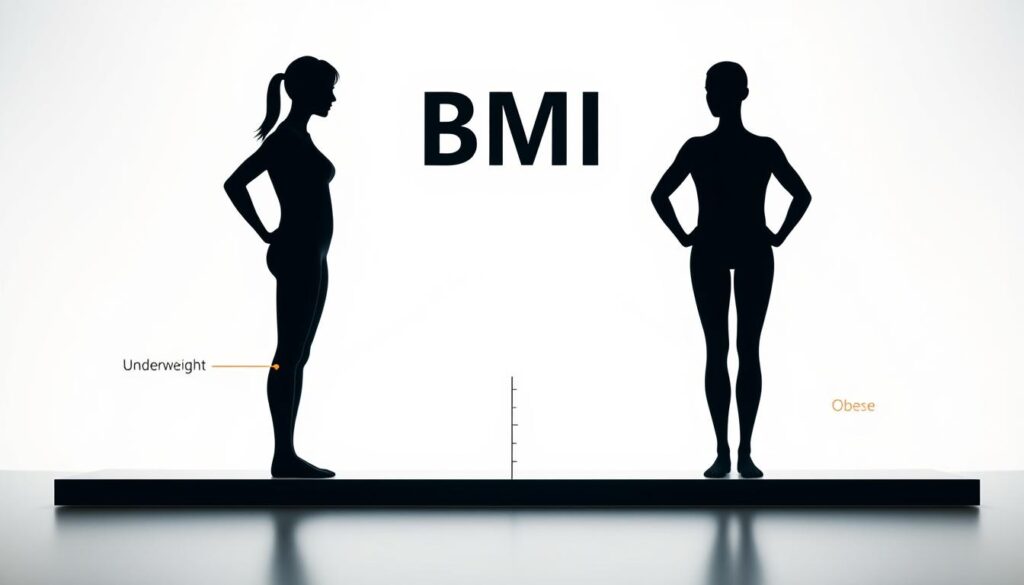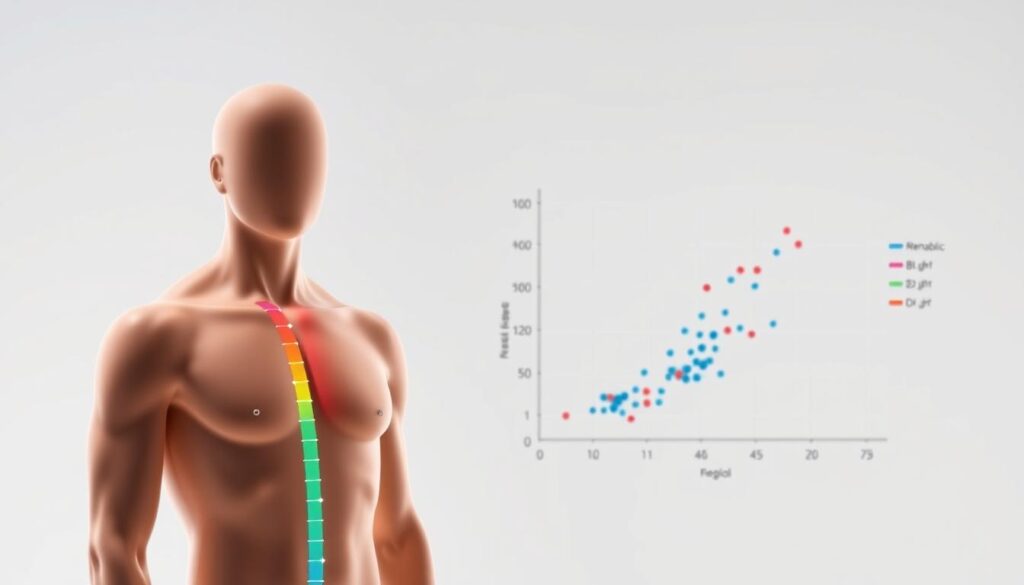Do you know your body’s health might not match your age? Metabolic age is a key indicator of your health and fitness.
We often use BMI (Body Mass Index) to check our weight. But it’s not the full picture. Knowing how BMI and metabolic age relate can help us get healthier. Studies show a healthy BMI and metabolic age lower health risks.
Working towards an ideal weight and better metabolic health can lower health risks. This section will introduce these important concepts.
Key Takeaways
- Understanding BMI and metabolic age is crucial for assessing overall health.
- A healthy BMI is a key indicator of fitness and lower health risks.
- Metabolic age provides insights into your body’s health status beyond chronological age.
- Achieving an ideal weight can significantly reduce health risks.
- Focusing on metabolic health can improve overall well-being.
Understanding BMI: A Key Health Metric
Body Mass Index, or BMI, is a key way to check our weight and health. It’s a simple tool for doctors to see if we might face weight-related health issues.
What is BMI?
BMI uses our weight and height to guess our body fat. It helps figure out if our weight is healthy for our height. Health experts say, “BMI is a good way to check if we might have weight-related health problems.”
How is BMI Calculated?
To find BMI, divide your weight in kilograms by your height in meters squared. The formula is: BMI = kg/m2. For example, if you weigh 70 kilograms and are 1.75 meters tall, your BMI is 22.86.
Many health websites and apps have BMI calculators. They make it easy to find your BMI by just entering your height and weight.
BMI Categories Explained
After calculating, BMI falls into different weight categories. These are:
- Underweight: BMI is less than 18.5
- Normal weight: BMI is 18.5 to 24.9
- Overweight: BMI is 25 to 29.9
- Obese: BMI is 30 or more
Knowing these categories is important. They show different health risks. Being underweight or obese can lead to serious health problems like heart disease and diabetes.
The World Health Organization says, “BMI is a good sign of chronic disease risk. Diseases like heart disease, stroke, and diabetes are big killers worldwide.”
Understanding our BMI helps us manage our weight. It’s a first step to lower the risk of weight-related health issues.
The Concept of Metabolic Age
Understanding metabolic age is key to optimal health. It shows how well our body works compared to others our age. This idea is important because it helps us see our health in a new way.
Defining Metabolic Age
Metabolic age is found by comparing your basal metabolic rate (BMR) to the average BMR of people your age. BMR is the calories your body needs for basic functions. This comparison tells us about our metabolic health compared to others our age.
How It Differs from Chronological Age
Chronological age is just how old we are. But metabolic age shows how our body works compared to our age. If your metabolic age is lower than your chronological age, you have a healthier metabolism. This means you might be less likely to get age-related diseases.
On the other hand, a higher metabolic age could mean your metabolism is slower. This might lead to health problems. Knowing the difference between these ages can push us to make better choices. Like exercising regularly and eating a balanced diet to boost our metabolic health.
The Relationship Between BMI and Metabolic Age
BMI and metabolic age are two important health metrics. They help us understand our metabolic health. Knowing how they relate is key for effective weight management and staying healthy.
How BMI Affects Metabolic Age
Studies show a link between BMI and metabolic age. A higher BMI often means a higher metabolic age, showing poorer health. More body fat, which comes with a higher BMI, can cause insulin resistance and other health problems.
By keeping a healthy BMI through diet and exercise, we can improve our metabolic age.
To find our BMI, we can use an online BMI calculator. It quickly tells us based on height and weight. For more on metabolic age, check out Healthline’s article.
Indicators of Healthy BMI and Metabolic Age
Keeping a healthy BMI and metabolic age requires good nutrition, exercise, and stress management. A healthy BMI is between 18.5 and 24.9. A good metabolic age is close to or less than our real age, showing good health.
- Check our BMI often to keep it healthy.
- Stay active to improve body and metabolic health.
- Eat well to support our health.
By focusing on these, we can get a healthier BMI and metabolic age. This helps us stay healthy and live longer.
Factors Influencing Metabolic Age
Many things affect our metabolic age, from our daily habits to our genes. Knowing these factors helps us make better health choices.
Lifestyle Choices and Their Impact
Our lifestyle choices greatly affect our metabolic health. Diet, exercise, and stress management are key. Our daily decisions can either help or hurt our metabolic age.
- Eating a balanced diet keeps our metabolism healthy.
- Regular exercise burns calories and boosts metabolic efficiency.
- Stress management, like meditation or yoga, helps our metabolism.
By making smart lifestyle choices, we can improve our metabolic health. This leads to a better metabolic age.
The Role of Genetics in Metabolic Age
Genetics also play a big part in our metabolic age. They affect our metabolic rate, body composition, and how we respond to diet and exercise.
Knowing about genetic factors helps us make better lifestyle choices. For example, some may need to work harder to stay healthy due to their genes.
By understanding genetics and making healthy lifestyle choices, we can improve our metabolic health. This helps us reach our fitness goals.
Ways to Improve Our BMI and Metabolic Age
By focusing on key lifestyle factors, we can significantly improve our BMI and metabolic age. This leads to better overall health.
Incorporating Regular Exercise
Regular physical activity is key to improving both BMI and metabolic age. Exercise burns calories and builds muscle, boosting metabolic rate.
We should aim for at least 150 minutes of moderate-intensity aerobic activity or 75 minutes of vigorous-intensity aerobic activity per week. Also, muscle-strengthening activities on two or more days a week are important.
The Importance of Nutrition
A balanced diet is crucial for a healthy BMI and metabolic age. Eating whole foods like vegetables, fruits, whole grains, lean proteins, and healthy fats is essential. It provides the necessary nutrients while keeping calorie intake in check.
It’s also beneficial to limit processed and high-calorie foods. These can negatively affect our metabolic health.
Stress Management Techniques
Chronic stress can negatively impact both BMI and metabolic age. It can influence eating habits and metabolism. Practicing stress-reducing techniques like meditation, yoga, or deep breathing exercises can help.
Regular physical activity also helps reduce stress. This contributes to a healthier metabolic rate and overall well-being.
Monitoring and Evaluating Our Progress
Improving our BMI and metabolic age is a big goal. Tracking our progress is key. We can use health tracking tools and resources to see changes in our body composition.
Tracking Health Metrics
Tools like body fat scales, fitness trackers, and mobile apps help us track our health. They give us insights into our progress. This helps us make better health choices.
Benefits of Regular Health Assessments
Regular health checks have many benefits. They help spot health risks early and show if our lifestyle changes work. By tracking our metabolic age and body composition, we can improve our health plan.
Understanding Changes
It’s important to understand the changes in our body as we track our progress. Analyzing these changes helps us fine-tune our health improvement strategies. This leads to a healthier lifestyle.




